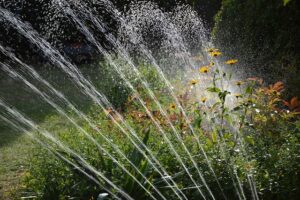Drip irrigation systems are a fantastic way to conserve water and ensure your plants receive the precise amount of moisture they need. However, like any irrigation system, drip irrigation sprinklers can sometimes break or become clogged, leading to inefficiencies and potential damage to your plants. Fortunately, fixing a broken drip irrigation sprinkler is a straightforward task that you can easily handle yourself. Here’s a comprehensive guide to help you through the process.
Identifying the signs of a broken or clogged drip irrigation sprinkler is crucial for timely repair:
Before starting any repairs, ensure the water supply to your drip irrigation system is turned off. This prevents water from spilling out and allows you to work safely and efficiently. Contact us if you need to schedule a repair service.
Identify the broken or clogged sprinkler. Run the system briefly to pinpoint the issue, then turn it off again. Look for areas with pooling water, dry spots, or visible damage.
Carefully examine the problematic sprinkler and the surrounding tubing for visible damage or clogs. Sometimes, the issue may be due to debris blocking the emitter or a small puncture in the tubing.
Gently remove the broken or clogged sprinkler from the tubing. Depending on your system, you may need to unscrew it or simply pull it out. Be careful not to damage the tubing while doing this. Contact us if you need to schedule a repair service.
Contact us if you need to schedule a repair service.
If the tubing is damaged, you will need to cut out the damaged section. Use scissors or garden shears to make clean cuts on either side of the damaged area. Connect the cut ends using a barbed connector or hose repair coupling. Make sure the connections are secure and watertight. Contact us if you need to schedule a repair service.
Using a punch tool, create a small hole in the tubing where you want to place the new sprinkler. Insert the barbed end of the new sprinkler into the hole, ensuring it fits snugly. If you’re replacing an emitter, simply push the new emitter into the tubing where the old one was removed. Contact us if you need to schedule a repair service.
Turn the water supply back on and run the drip irrigation system to test the new sprinkler. Check for proper operation, ensuring water is flowing correctly and there are no leaks. Contact us if you need to schedule a repair service.
Adjust the positioning of the new sprinkler if necessary to ensure even water distribution. Check surrounding emitters to ensure they’re working properly, as the system may have been affected by the initial problem.
Contact us if you need to schedule your irrigation maintenance service.
Fixing a broken drip irrigation sprinkler is a simple and effective way to maintain the efficiency of your irrigation system and ensure your plants receive the water they need. By following this step-by-step guide, you can easily handle the repair yourself, keeping your garden in top shape. Regular maintenance and attentive care can prevent future issues and prolong the life of your drip irrigation system.
We provide professional irrigation repair services, such as maintenance, repair, and troubleshooting of your irrigation systems. These services are essential for ensuring the proper functioning and efficiency of irrigation systems for your lawns, gardens, and other green spaces.
Yes, irrigation systems can experience issues and break even during dry weather. Here are a few reasons why irrigation systems might break or malfunction during dry conditions:

During dry weather in Las Vegas, the demand for irrigation systems typically rises as plants and lawns require more water. Increased usage can put additional strain on the system, leading to issues such as clogged nozzles, broken pipes, or malfunctioning valves.
In an effort to compensate for the dry conditions, some users may run their irrigation systems for longer durations or more frequently. Continuous operation or excessive watering can overload the system and cause components to fail.
Prolonged dry spells can cause soil to shrink, shift, or crack. These changes in the ground can put stress on pipes and fittings, leading to leaks or breaks in the irrigation system.
In dry weather, water sources may experience fluctuations in pressure. High water pressure can damage sprinkler heads or cause pipes to burst, while low pressure can result in inefficient water distribution or system failure.

Neglecting routine maintenance can increase the likelihood of system failures. Over time, debris, dirt, and mineral deposits can accumulate in the system, obstructing water flow and affecting the performance of valves, nozzles, and other components.
System Inspection and Evaluation: Our technicians will assess the overall condition of the irrigation system, including sprinklers, pipes, valves, and controllers. They will identify any issues or areas that require repair.
Leak Detection and Repair: If there are leaks in the system, our irrigation repair technician will locate and repair them. Leaks can waste water and cause damage to the landscape if not addressed promptly.
Sprinkler Repair and Adjustment: Broken or malfunctioning sprinkler heads, nozzles, or valves will be repaired or replaced as needed. Our technician will also ensure that the sprinkler heads are properly adjusted to provide adequate water coverage.
Controller and Timer Troubleshooting: If the irrigation controller or timer is not functioning correctly, the repair service will diagnose and fix the issue. We may have to reprogram the controller or replace faulty components.
Pipe and Valve Repair: Damaged or broken pipes and valves will be repaired or replaced to restore proper water flow and prevent water waste.
System Upgrades and Retrofitting: Our irrigation repair services include upgrades and retrofitting options to improve the efficiency and effectiveness of the irrigation system. This could include installing water-saving devices, such as rain sensors or drip irrigation systems.
Seasonal Maintenance: Regular maintenance visits may be scheduled to prepare the irrigation system for different seasons. This may involve adjusting watering schedules, clearing clogged nozzles, and checking system performance.
GET IN TOUCH